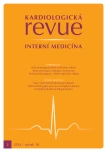Centraly acting antihypertensives – rilmenidine
Authors:
M. Souček
Authors‘ workplace:
II. interní klinika LF MU a FN u sv. Anny v Brně a ICRC, Brno
Published in:
Kardiol Rev Int Med 2014, 16(2): 153-146
Category:
Internal Medicine
Overview
Rilmenidine is an antihypertensive from the group of imidazoline receptor agonists. The basis of its mechanism of action is significant reduction of cardiac and renal sympathetic baroreflex response at the level of I1- imidazoline receptors with subsequent reduction of the sympathetic activity. The effectiveness and tolerability of rilmenidine were proved in randomized comparative studies in elderly patients, patients suffering from hypertension together with diabetes and metabolic syndrome, and in patients with renal failure. The indication for administering rilmenidine is treatment of essential hypertension in adult patients of all age groups. The recommended dose is 1 mg a day (in the morning).
Keywords:
sympathetic nervous system – I1‑ receptors – hypertension – rilmenidine
Sources
1. Adámková V. Agonisté I1- imidazolinových receptorů a jejich užití v klinické praxi Medicína po promoci 2013; 14: 15– 18.
2. Souček M, Vnoučková K. Rilmenidnum. Remedia 2004; 14: 282– 289.
3. Souček M. Pozice blokátorů imidazolinových receptorů v léčbě hypertenze. Remedia 2009; 19: 153– 157.
4. Prokopova R, Matveev M, Nachev Ch. Heart autonomic balance changes after peripheral and central supression of sympathetic hyperactivity in mildly hypertensive individuals. J Hypertens 2005; 23 (Suppl 2): S382.
5. Panfilov J, Morris AD, Donnelly R et al. Comparative effects of rilmenidine and atenolol on tests of autonomic function in patients with essential hypertension. J Cardiovasc Pharmacol 1995; 26 (Suppl 2): S44– S47.
6. Anichkov DA, Shostak NA, Schastnaya OV. Comparison of rilmenidine and lisinopril on ambulatory blood pressure and plasma lipid and glukose levels in hypertensive women with metabolic syndrome. Curr Med Res Opin 2005; 21: 113– 119.
7. Bauduceau B, Mayaudon H, Dupuy O. Efficacy of rilmenidine versus captopril on microalbuminuria: a pilot study in hypertensive type 2 diabetics. J Cardiovasc Risc 2000; 7: 57– 61.
8. Luccioni R. Evaluation pharmaco‑ epidemiloque de la rilmenidine chez 18,235 hypertendus. Presse Med 1995; 24: 1857– 1864.
9. Trimarco B, Rosiello G, Sarno D et al. Effects of one‑year treatment with rilmenidine on systemic hypertension‑induced left verticular hypertrophy in hypertensive patiens. Am J Cardiol 1994; 74: 36A‑ 42A.
10. Lengyel M, Borbas S, Zorandi A. Regression of left ventricular hypertrophy in mild‑ to‑ moderate hypertension in one year of treatment with rilmenidine. Eur Heart J 2000; 21 (Suppl): 101.
11. Farsang C, Lengyel M, Borgis S et al. Value of rilmenidine therapy and its combination with perindopril on blood pressure and left ventricular hypertrophy in patients with essential hypertension (VERITAS). Curr Med Res Opin 2003; 19: 205– 217.
12. Meredith PA, Reid JL. Efficacy and tolerability of long‑term rilmenidine treatment in hypertensive diabetic patients. A retrospective analysis of a general practice study. Am J Cardiovasc Drugs 2004; 4: 195– 200.
13. Remková A, Kratochvíl'ová H. Effect of the new centrally acting antihypertensive agent rilmenidine on endothelial and platelet function in essential hypertension. J Hum Hypertens 2002; 16: 549– 555.
14. Widimský J, Sirotiaková. Efficacy and tolerability of rilmenidine compared with isradipine in hypertensive patients with features of metabolic syndrome. Curr Med Res Opin 2006; 22: 1287– 1294.
Labels
Paediatric cardiology Internal medicine Cardiac surgery CardiologyArticle was published in
Cardiology Review

2014 Issue 2
Most read in this issue
- Centraly acting antihypertensives – rilmenidine
- Mechanical circulatory support in the treatment of cardiogenic shock – review
- Mechanical circulatory support and heart transplantation for treatment of chronic heart failure
- Non‑ pharmacological treatment of heart failure in terms of the new European guidelines for resynchronization therapy
